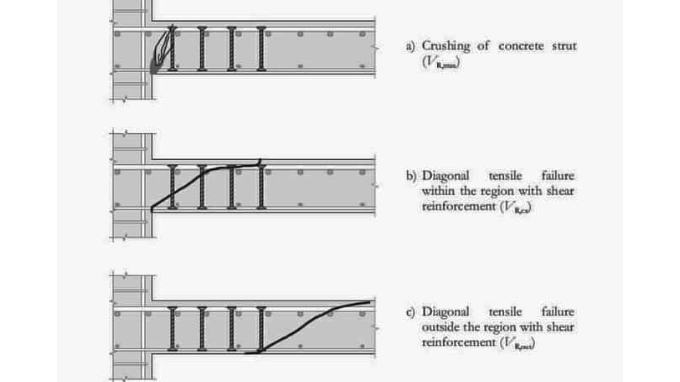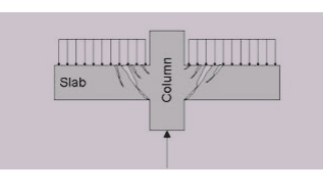Table of Contents
Definition
Punching shear is a severe failure mechanism that occurs in structural members, such as slabs and foundations, when subjected to concentrated loads.
Description
This type of failure arises from the shear forces acting on a smaller area within the structural elements, typically due to the reaction from a column acting against a slab. As a result, the slab becomes susceptible to failure, potentially leading to the load punching through the slab.

Concentrated loads on a slab can originate from various sources, including columns, especially those supported by pad foundations, as well as wheel loads. This concentrated force applied to the slab may also manifest in a flat slab scenario, where the slab is supported by a column, leading to a high concentration of shear force around the column head.
Punching shear failure occurs when the total shear force surpasses the shear resistance of the slab. Consequently, the slab is forcefully pushed down around the column, giving the impression that the column has punched through the slab.
This failure mechanism is commonly observed in various structural elements, including normal floor slabs, flat slabs, and foundation slabs below columns. However, in pad foundations, where weight and depth are not critical factors, the effects of punching shear can be mitigated by providing sufficient depth.
Punching shear is a crucial consideration in the design and analysis of structural members. Proper measures must be taken to ensure that the shear forces acting on the slabs and foundations do not exceed their shear resistance, thereby preventing catastrophic failures and ensuring the safety and integrity of the entire structure.
Punching Shear In Concrete Slab
The punching shear in reinforced concrete slabs can be analogized as a 2D counterpart of the shear observed in beams, leading to a sudden rupture. The main reinforcement is unable to restrain this type of failure.

As a result, the ultimate load capacity of the structure is reduced below the flexural capacity due to shear forces. However, it is important to note that compared to beam shear, punching shear is considered less critical.
Punching shear occurs in slabs when they bear high concentrations of loads, such as wheel loads on bridge slabs or the loads from upper floors acting on the columns that support the slab floors
Punching Shear Calculation in Structural Design
Punching shear calculations play a crucial role in the design of slabs and foundations, as they involve assessing the force exerted on the thickness of the structure. However, for this assessment to be accurate, it is essential that the system experiences shear forces alone and not any form of moment in the pedestal or column.
The determination of the Maximum Punching Shear Stress relies on considering the punching shear failure cone and the applied values of shear and moments.
In this context, ‘d’ denotes the effective depth of the slab. The punching shear perimeter is formed at a distance of d/2 from the edges of the column or the pedestal, where the critical forces are concentrated.
By carefully analyzing these factors and accurately calculating the punching shear, engineers can ensure the structural integrity and safety of the building. It is imperative to consider the unique characteristics of each project, as this process demands a comprehensive understanding of the specific load-bearing requirements and the potential vulnerabilities of the structure.
Punching shear is a critical design consideration for slabs, especially in reinforced concrete structures. It refers to the failure of a slab at the perimeter of a column or other vertical load-bearing element due to concentrated loads. To ensure the safety and integrity of a structure, several design considerations for punching shear must be taken into account:
- Code requirements: The design of punching shear should be in accordance with the relevant building codes and standards, which typically provide specific guidelines and formulas for calculating the required shear resistance.
- Load calculation: Calculate the factored loads acting on the slab, including dead loads, live loads, and other imposed loads. The magnitude of the loads will impact the design of the slab’s shear reinforcement.
- Column dimensions and shape: The size and shape of the column directly affect the punching shear forces. Larger or irregularly shaped columns can lead to higher shear forces, requiring more shear reinforcement.
- Slab thickness: The thickness of the slab plays a crucial role in punching shear resistance. Thicker slabs generally provide better punching shear capacity.
- Concrete strength: The compressive strength of the concrete influences the punching shear resistance. Higher-strength concrete can improve the punching shear capacity.
- Reinforcement detailing: Proper detailing of the slab’s reinforcement is essential to enhance punching shear capacity. This includes providing sufficient shear reinforcement around the column perimeter.
- Shear reinforcement: Use appropriately designed shear reinforcement, such as shear studs, shear heads, or stirrups. The type, size, and spacing of the shear reinforcement should be selected based on the design loads and the structural requirements.
- Minimum clear distance to the nearest face of the column: Codes typically specify a minimum clear distance between the column face and the nearest point of concentrated load to prevent premature shear failure.
- Edge distance: Adequate edge distance between the perimeter column and the nearest point of concentrated load should be maintained to avoid failure at the edges of the slab.
- Transfer beams and drop panels: In cases where higher punching shear capacity is required, transfer beams or drop panels can be incorporated to redistribute the loads from columns to a wider area.
- Consideration of openings: If there are openings or penetrations in the slab, their proximity to the column must be considered in the design to avoid compromising the punching shear capacity.
- Slab layout and geometry: The layout and geometry of the slab should be optimized to reduce critical shear regions and distribute loads more evenly.
- Construction joints: Proper detailing and reinforcement around construction joints are crucial to maintaining the punching shear capacity at these vulnerable locations.
Conclusion
The evaluation of punching shear is a vital aspect of structural design, and its accurate calculation ensures the stability and reliability of the entire construction. By adhering to rigorous analysis and design principles, engineers can create robust and resilient structures capable of withstanding various external forces over time.
